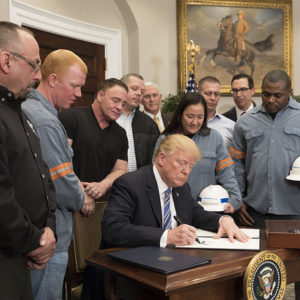Economic policy consistency is evidently not the Trump administration’s long suit. If ever one doubted that proposition all one need do is look at how the administration’s China trade policy proposals conflict with its budget policy. That policy conflict is not likely to end well for the U.S. and global economies.
A principal objective of President Trump’s America First trade policy is to eliminate the U.S. trade deficit in general and that with China in particular. To that end, Trump has announced an increase in steel and aluminum import tariffs as well as increased tariffs on $60 billion in Chinese imports. In addition, he is demanding that China takes measures to reduce its trade deficit by $100 billion.
At the same time that Trump is implementing an American First trade policy, he is also pursuing an expansionary budget policy. He is doing so even though the Federal Reserve judges that the U.S. economy is at or beyond full employment. In this context, he has introduced an unfunded tax cut, which according to the Congressional Budget Office will increase the U.S. budget deficit by $1.5 trillion over the next decade. He has also gone along with a congressional spending bill that will increase public spending by $300 billion over the next two years.
Sadly, the Trump administration seems to be blissfully unaware that a necessary condition for the reduction of the U.S. trade deficit is that the United States must raise its savings rate relative to its investment rate. This holds true whatever the administration might do with import restrictions and with exchange rate policy. Overlooking this basic point of economics seems to be blinding the administration to the fundamental inconsistency between its trade policy objectives and its budget policy proposals.
According to the Committee for a Responsible Budget, the tax and spending measures will increase the U.S. budget deficit from $660 billion in 2017 to more than $ 1.1 trillion by as early as 2019. At a time that U.S. household saving has sunk to very low levels, the prospective widening in the budget deficit will almost inevitably reduce the overall level of savings. By so doing, it will also cause the trade deficit to widen as it did in the time of the Reagan twin deficits.
A clear and present danger to the U.S. and global economic outlook is that a widening of the trade deficit would heighten the chances that the world will drift toward a destructive trade war. It would do so by raising the prospect that a misguided Trump would double down on import restrictions as a response to a further widening in the trade deficit.
Another area in which the administration’s China trade policy conflicts with its budget policy relates to the financing of the budget deficit. One has to question the wisdom of picking a fight with China, the largest holder of U.S. Treasuries, at precisely the time when the budget is set to double, approximately, over the next two years. This would seem to be all more so the case considering that nowadays, rather than being a large buyer of Treasuries, the Federal Reserve has become a seller in its efforts to shrink its bloated balance sheet.
At a time when global asset prices have reached lofty levels, the last thing that the Trump administration needs is a spike in long-term government bond rates that could roil U.S. and global financial markets. Yet that is what the administration now seems to be inviting. It is doing so by antagonizing the largest holder of U.S. Treasuries at precisely the time when the government’s borrowing needs are set to rise sharply.
Given the stakes involved for both the U.S. and global economies, one has to hope that Trump will find a way to back down from his unilateral America First trade policy. However, judging by his past rhetoric and by the recent changes in his economic team, I am not holding my breath for that to happen.

